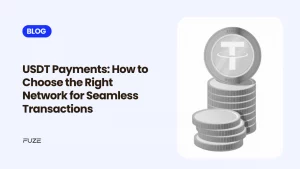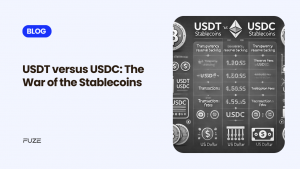Cryptocurrencies are known for high volatility, with their prices fluctuating intermittently based on supply and demand, regulatory actions, market manipulation, or social media contagion. One of the most notable instances is the 2011 Mt. Gox hack, which led to a dramatic decline in Bitcoin’s value. Such incidents have led to perilous periods in crypto markets known broadly as ‘crypto winter’, periods where asset values drop and trading volumes decline.
Stablecoins emerged as a solution to address the volatility of cryptocurrencies. These digital assets, designed to maintain a stable value, are often pegged to a fiat currency like the US dollar. By mitigating price fluctuations, stablecoins offer a more reliable and predictable investment option. This post delves into the mechanics of stablecoins, their role in bridging traditional and digital finance, and their use cases in everyday businesses.
What are Stablecoin and Do They Work
Stablecoins are a class of cryptocurrencies designed to maintain a stable value, typically pegged to a fiat currency like the US dollar. Unlike volatile cryptocurrencies, stablecoins offer a more predictable and reliable store of value. This stability is achieved through various mechanisms, including collateralization, algorithmic price stabilisation, and reserve-backed models. The growing popularity of stablecoins is evident in their rapid adoption. For instance, Tether and USD Coin have experienced significant growth in recent years, demonstrating the increasing demand for stable digital assets.
Type of stablecoins can vary under the following:
Fiat-Collateralized Stablecoins:
These are the most straightforward type of stablecoin, directly pegged to a specific fiat currency like the US Dollar. Examples include Tether (USDT) and USD Coin (USDC). In most cases, one unit of the stablecoin equates to one unit of the underlying fiat currency.
Commodity-Backed Stablecoins:
Less common, these stablecoins are pegged to the market value of physical commodities, such as gold. This offers investors a different form of diversification. Tether Gold (XAUt) is a prime example, backed by gold reserves.
Cryptocurrency-Backed Stablecoins:
These stablecoins use other cryptocurrencies as collateral. While this can introduce volatility due to fluctuating crypto prices, overcollateralization is often employed to mitigate risk. For instance, Dai (DAI) is pegged to the US Dollar but secured by Ethereum (ETH).
Algorithmic Stablecoins:
A more innovative approach, algorithmic stablecoins rely on smart contracts and economic incentives to maintain price stability without requiring a traditional custodian. These algorithms monitor the market price and automatically adjust supply and demand to keep the stablecoin pegged to its target, usually a fiat currency.
Stablecoins: The Bridge Between TradFi and DeFi
Stablecoins, with their inherent price stability, serve as a crucial bridge between traditional finance (TradFi) and decentralised finance (DeFi). They facilitate the seamless integration of these two worlds, enabling a wide range of financial activities.
Key Ways Stablecoins Bridge the Gap:
- Seamless Value Transfer: Stablecoins allow for the efficient transfer of value between traditional financial institutions and DeFi platforms. They can be used to convert fiat currency into digital assets, and vice versa.
- Enabling DeFi Applications: Stablecoins power a variety of DeFi applications, including decentralised exchanges (DEXs), lending platforms, and yield farming protocols. They provide a reliable medium of exchange and a store of value within the DeFi ecosystem.
- Reducing Volatility Risk: By offering price stability, stablecoins mitigate the risks associated with the volatile nature of cryptocurrencies. This enables more traditional financial institutions to participate in DeFi without exposing themselves to excessive price fluctuations.
- Facilitating Cross-Border Transactions: Stablecoins can streamline cross-border transactions by reducing the need for intermediaries and traditional banking systems. They can enable faster and more cost-effective international payments keeping asset value equivalent across transactions.
Stablecoin Use Cases for Everyday Businesses
Stablecoins, with their price stability, offer a range of benefits for everyday businesses:
1. Efficient Payments and Settlements:
- Faster Transactions: Blockchain-based transactions, powered by stablecoins, can be processed faster than traditional payment methods, reducing processing time and accelerating cash flow.
- Lower Transaction Fees: Stablecoin transactions often involve lower fees compared to traditional payment methods, particularly for cross-border transactions.
- Reduced Fraud Risk: Smart contracts can automate and secure payment processes, minimising the risk of fraud and errors.
2. Global Trade and Remittances:
- Cross-Border Payments: Stablecoins can facilitate seamless cross-border payments, reducing the time and cost associated with traditional international transfers.
- Currency Exchange Efficiency: By using stablecoins, businesses can avoid the complexities and fees associated with currency exchange.
3. Treasury Management and Liquidity:
- Stable Value: Stablecoins can be held as a stable store of value, protecting against currency fluctuations and inflation.
- Improved Liquidity: Businesses can easily convert stablecoins into fiat currency or other digital assets, enhancing liquidity and financial flexibility.
4. Employee Compensation and Benefits:
- Global Payroll: Stablecoins can be used to pay employees globally, regardless of their location.
- Flexible Benefits: Businesses can offer employees the option to receive a portion of their compensation in stablecoins, providing them with additional financial flexibility.
Advantages of Using Stablecoins for Global Transactions
Stablecoins offer several advantages for global transactions:
1. Faster and Cheaper Transactions:
- Reduced Processing Time: Blockchain technology enables near-instantaneous transactions, significantly reducing processing time compared to traditional banking systems.
- Lower Transaction Fees: Stablecoin transactions often incur minimal fees, making them a cost-effective option for international transfers.
2. 24/7 Accessibility:
- Global Reach: Stablecoins can be accessed 24/7, regardless of time zones or bank holidays.
- Borderless Transactions: They facilitate seamless cross-border transactions without the limitations of traditional banking systems.
3. Enhanced Security and Transparency:
- Blockchain Technology: Stablecoins leverage blockchain technology to ensure the security and transparency of transactions.
- Immutable Records: Every transaction is recorded on a public ledger, making it difficult to manipulate or dispute.
4. Increased Financial Inclusion:
- Accessibility: Stablecoins can provide financial services to individuals and businesses who may be underserved by traditional banking systems.
- Lower Barriers to Entry: By reducing the barriers to entry, stablecoins can empower individuals and businesses to participate in the global economy.
5. Price Stability:
- Reduced Volatility: Unlike volatile cryptocurrencies, stablecoins are pegged to a stable asset like a fiat currency, reducing price fluctuations.
- Predictable Value: This price stability makes them more suitable for international transactions and long-term savings.
Conclusion
In conclusion, stablecoins represent a powerful bridge between traditional finance and the dynamic world of digital assets, offering businesses a reliable solution for transactions amidst the volatility often associated with cryptocurrencies. By leveraging stablecoins, companies can enhance transaction speed, reduce costs, and access a broader market, all while maintaining the stability necessary for effective financial management.
At Fuze, we understand the importance of seamless payment solutions in today’s rapidly evolving landscape. Our platform simplifies the acceptance of stablecoin payments, providing businesses with the tools they need to integrate these digital assets into their payment systems effortlessly. With Fuze, you can streamline your financial operations, enjoy lower transaction fees, and tap into the growing community of crypto users—all while ensuring a stable and secure payment experience. Embrace the future of finance with Fuze and discover the benefits of accepting stablecoins today!
Disclaimer: Virtual assets carry significant risks, including high volatility and potential loss of your entire investment. They are not backed by governmental protections, and recourse may be limited in case of loss. Always assess your risk tolerance, fully understand the risks, and seek independent financial advice if needed before investing.
Frequently Asked Questions
1. Are stablecoins safe to use?
While stablecoins are generally designed to provide stability, their safety depends on the underlying assets and the mechanisms used for maintaining the peg. It’s essential to choose reputable stablecoins that have transparent backing and regulatory compliance. Conducting thorough due diligence on the stablecoin provider is crucial for ensuring safety and security.
2. How do stablecoins impact my business’s cash flow?
Stablecoins can improve cash flow by facilitating faster transactions and reducing payment processing fees. They also enable businesses to receive payments in real-time, which can help improve liquidity and manage cash flow more effectively, particularly in cross-border transactions.
3. What are the risks associated with accepting stablecoins?
While stablecoins offer many benefits, there are risks to consider, including regulatory uncertainties, potential loss of peg value, and market liquidity issues. Businesses should evaluate these risks and implement appropriate measures, such as maintaining diversified payment options and closely monitoring stablecoin performance.
4. How can accepting stablecoins enhance customer experience?
Accepting stablecoins can enhance customer experience by providing more payment options, especially for tech-savvy customers and those in regions with limited banking access. It also allows for faster, hassle-free transactions, contributing to a smoother checkout process and overall satisfaction.
5. Can stablecoins be converted to fiat currency easily?
Yes, stablecoins can typically be converted to fiat currency through various cryptocurrency exchanges and payment platforms. The ease of conversion may vary depending on the specific stablecoin and the exchange used, but many platforms offer straightforward processes for cashing out.







